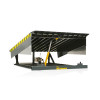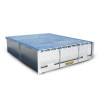Practical Tips for Optimizing Your Charging Springs
Main tips of the document
1. Height of loading springs
The proper height of a loading dock is crucial to ensuring efficiency and security in operations. Determining the right height can make a big difference in loading and discharge time, as well as in accident prevention. Our document provides a detailed guide to calculate the ideal height based on your specific needs and types of vehicles you use.
2. Earring of loading springs
The slope is another vital factor that affects the functionality of loading springs. A poorly designed slope can make it difficult to traffic vehicles and increase the risk of accidents. In our guide, we explain the importance of the slope and how to handle it correctly to facilitate the safe and efficient movement of vehicles in the load and download area.
3. Longitude of loading springs
Complying with specific recommendations on the length of loading springs is essential to maintain an optimal workflow. The right length allows for better maneuverability of vehicles and ensures that load and discharge operations are performed smoothly. Our document provides clear guidelines on the dimensions to be considered to maximize operational efficiency.
4. Optimal distances
Optimizing distances on your loading springs is critical to improving operational efficiency. This not only reduces waiting times, but also facilitates a more organized workflow. Our guide offers practical advice to configure the right distances between different elements of the dock, thus ensuring a more productive working environment.
5. Security measures
Safety at loading docks cannot be underestimated. Implementing appropriate security measures is crucial to protect your team and avoid accidents. In our document, we discuss various security strategies and equipment that you can implement to ensure a safe working environment. From proper signaling to personal protective equipment, we provide all the necessary tools to keep your staff safe.
Share this content


